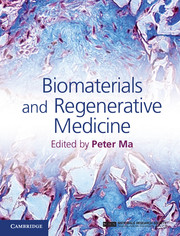Book contents
- Frontmatter
- Contents
- List of contributors
- Preface
- Part I Introduction to stem cells and regenerative medicine
- Part II Porous scaffolds for regenerative medicine
- Part III Hydrogel scaffolds for regenerative medicine
- Part IV Biological factor delivery
- 20 Growth factor delivery on scaffolds
- 21 Gene delivery for periodontal regeneration
- 22 Endogenous stem/progenitor cell recruitment for tissue regeneration
- 23 Affinity-based delivery systems
- 24 DNA delivery for regeneration
- Part V Animal models and clinical applications
- Index
- References
20 - Growth factor delivery on scaffolds
from Part IV - Biological factor delivery
Published online by Cambridge University Press: 05 February 2015
- Frontmatter
- Contents
- List of contributors
- Preface
- Part I Introduction to stem cells and regenerative medicine
- Part II Porous scaffolds for regenerative medicine
- Part III Hydrogel scaffolds for regenerative medicine
- Part IV Biological factor delivery
- 20 Growth factor delivery on scaffolds
- 21 Gene delivery for periodontal regeneration
- 22 Endogenous stem/progenitor cell recruitment for tissue regeneration
- 23 Affinity-based delivery systems
- 24 DNA delivery for regeneration
- Part V Animal models and clinical applications
- Index
- References
Summary
Introduction
Traditionally tissue engineering entails the seeding and culturing of differentiated somatic cells onto biodegradable scaffolds, with subsequent implantation of the cell–scaffold constructs into the defective or damaged sites to regenerate tissues [1]. In this approach, the scaffold acts as a three-dimensional (3D) framework to provide physical support and accommodate cell growth and deposition of extracellular matrices, and its biodegradability allows the scaffold material to be resorbed in pace with new tissue formation. Despite some encouraging successes in clinical trials [2, 3], two key limitations with this approach include the limited source of exogenous donor cells and the lack of adequate vascularity to maintain vitality of the newly regenerated tissues. To address these limitations, current advanced tissue engineering techniques gear toward harnessing a biomimetic scaffold that provides a synthetic regenerative microenvironment to support natural tissue regeneration and angiogenesis [4]. In addition to providing physical support, the ideal biomimetic scaffold would preferably also deliver bioactive factors, which instruct endogenous stem cell recruitment and differentiation three-dimensionally and in a controlled manner [5] (Figure 20.1). Various bioactive factors, including growth factors [6–8], nucleic acids [9], and integrin-binding ligands [10], have successfully been delivered or presented on biodegradable scaffolds. Among these, growth factors are the most important soluble signals in the natural regenerative microenvironment, being actively involved in stem cell recruitment, proliferation, and differentiation, angiogenesis, and tissue morphogenesis. Although they are potent, growth factors are expensive and have short half-lives in vivo. Therefore, scaffolds with controlled-release capacity are desired in order to preserve growth factor bioactivity and to prolong their function at therapeutic levels over an extended time period. However, there remain significant challenges in delivering growth factors effectively from scaffolds, including the need to preserve the bioactivity of growth factors during the possibly harsh incorporation process, the control of their release over an extended period during tissue regeneration, and the need for release to be restricted locally so as to avoid toxic or unwanted systemic side effects. Additionally, each individual delivery strategy is related, and sometimes restricted, to the type of scaffold utilized.
- Type
- Chapter
- Information
- Biomaterials and Regenerative Medicine , pp. 377 - 390Publisher: Cambridge University PressPrint publication year: 2014



